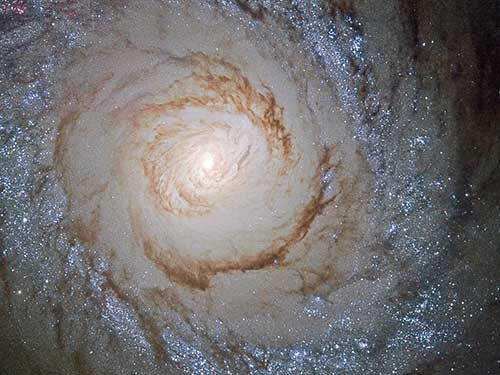Just like a murder of crows, a shrewdness of apes and a murmuration of starlings, tightly packed stars of a similar age within the center of a galaxy have a collective name: a bulge.
Most galaxies have bulges at their centers. Depending on their properties—specifically, the kinematics of their stars—the bulges have different names. Stars within classical bulges move a bit randomly, resembling elliptical galaxies, and seem to be older than their galaxy, while stars within pseudobulges move by rotation, like spiral galaxies, and don’t differ in age from their galaxy.
Astronomers use a galaxy’s stellar halo as a “fossil record” to study these bulges. Stellar halos can, for example, tell astronomers whether a galaxy has merged with another galaxy in its past.
A University of Michigan doctoral student has examined the pseudobulge of the nearby disk galaxy Messier 94 and has found that despite the galaxy having the largest pseudobulge in the local universe, likely no massive galaxies crashed into M94 in the past.
“Astronomers believe that when a galaxy merges with another galaxy, the merger will deposit material into the stellar halo of the galaxy it merged with,” said lead author Katya Gozman. “By investigating and learning about the stars and stellar populations in the stellar halo, we can study and find out information about the past mergers a galaxy had. You could say we’re doing extragalactic archaeology in the stellar halo around M94.”
But Gozman and her co-authors found no evidence of a massive merger in the galaxy’s history. Instead, a smaller merger likely happened, with a galaxy the size of the Small Magellanic Cloud—a dwarf galaxy approximately three times smaller than the Milky Way—crashing into M94.
Gozman used observational data generated by the Subaru Hyper Suprime-Cam, located in Hawaii, to look at M94’s stellar halo, the diffuse halo of stars that surrounds a galaxy. The stellar halo extends far beyond what a galaxy appears to be at first glance, and astronomers can examine this halo to look for remnants of past mergers. One way of learning about these remnants is to calculate the mass of a galaxy’s halo.
For this study, Gozman used the Subaru data to catalog stars in M94’s stellar halo according to their brightness. She plotted stars in what’s called a color magnitude diagram, which organizes stars according to their brightness as seen through certain filters used in astronomy to determine how much light a star is emitting.
Specifically, she looked at a type of star called a red-giant branch star, or an RGB star. These stars are luminous—a benefit for imaging them, Gozman says—and how red or blue the star is strongly correlates with what kinds of heavier, metallic elements they contain.
Gozman then divided the RGBs in the galaxy into two regions: RGBs whose light appeared more blue, and RGBs whose light appeared more red. The blue RGBs were metal poor while the red RGBs were more metal rich. She also plotted the stars’ distribution in the galaxy, determining that the red RGBs are concentrated in a ring around the center of the galaxy while the blue RGBs are dispersed around the outer parts of its halo.
Focusing on the blue RGBs, Gozman divided the galaxy into circular annuli, or concentric rings overlying the disk like a bullseye. By calculating the surface brightness of the stars in each ring, she was able to determine the mass of the stellar halo—which was not at all massive. The halo’s mass lets us infer the mass of the galaxy that merged into it.
“We use the mass of the halo to infer the mass of the galaxy that last crashed into the galaxy we’re examining,” Gozman said. “One might think that if a really large galaxy crashed into M94 a long time ago, that might have significantly altered the morphology, the components, of the galaxy and maybe that could have given rise to this really large pseudobulge in the center.”
But there was no large merger, Gozman found. The largest galaxy that crashed into M94 in the past was not massive at all. Instead, she says the pseudobulge likely formed just through the typical evolution of the galaxy.
However, very few studies have mapped the size of galaxy halos in this way. Gozman’s work to resolve the stars in M94’s stellar halo provides more information for astronomers who study galaxy mergers and evolution.
“This data is the first data we’ve ever had of the resolved stellar population of this galaxy. Resolving stars is a pretty hard thing to do, but it is one of the best ways you can actually look at the halos and learn about the merger history of the galaxy,” she said. “So this is another datapoint in a field of very few data points.”


